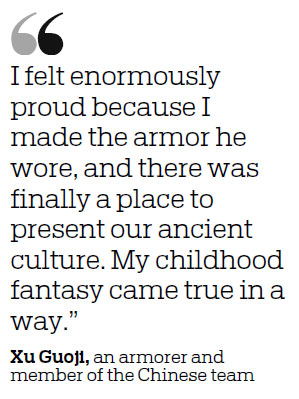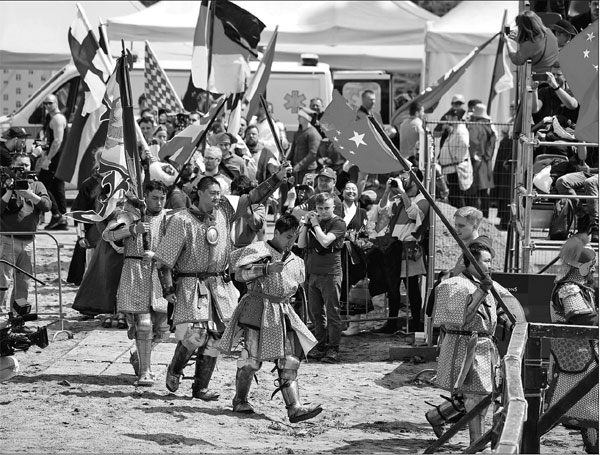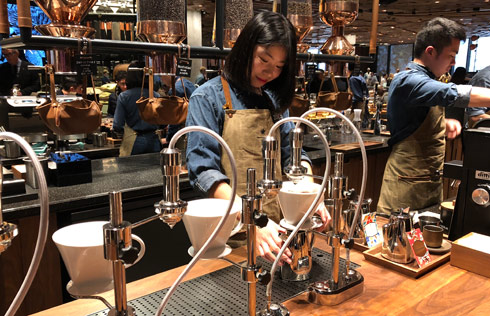Buhurt players fight to revive ancient glory
Medieval tournaments offer Chinese combatants the opportunity to use replica armor and weapons. Aybek Askhar reports.
As a thunderous cheer burst from the crowd, a trident-wielding warrior clad in armor styled on that worn during the Ming Dynasty (1368-1644) moved toward his adversary, an infantryman in Kievan Rus-style (882-1240) armor, who held a cross shield.
As the men collided, their hacking and slashing inflamed the passions of the crowd.

"He was provoked by my first strike. Although I was armed to the teeth, a ripple of fear passed through my body as I watched the infantryman slowly raise his ax. Somehow, I felt the air in the field had solidified, and I was a little regretful at being there at that moment," said Gao Peng, the Ming "warrior'.
The event, held in Ukraine, was not a themed carnival or movie set, but a genuine full-contact encounter with real weapons, metal armor and standardized rules.
In history, people never witnessed encounters between combatants from different continents and eras. However, three years ago, this "time-travel scene" became reality when a team from China took part in a buhurt tournament for the first time.
"The Western participants were amazed when Gao stepped onto the field, because they had never seen real Chinese armor before," said Xu Guoji, an armorer and member of the Chinese team.
Pride
"I felt enormously proud because I made the armor he wore, and there was finally a place to present our ancient culture. My childhood fantasy came true in a way."
Many people who were fascinated in childhood by stories of King Arthur or Joan of Arc probably shared the same fantasy as Xu - to become a knight and fight for glory.
In medieval Europe, nobles sponsored tournaments in which combatants tested their skills against each other. However, the decline of "cold" weapons - axes, swords and hammers - resulted in the tradition ending.
Despite that, the knights' strength and noble character continue to inspire enthusiasts, and the epic stories of medieval warfare fascinate modern audiences, especially in Eastern Europe.
"To embody their vision of a medieval tournament, enthusiasts from Eastern Europe created buhurt in the late 1990s. The name is derived from the old French word behourd, literally "to wallop", but it also refers to 'Historical Medieval Battles'," Gao said.
One of the main HMB events is the Battle of the Nations, which in 2009 was the first international medieval combat tournament. In 2016, during the annual BOTN meeting, the organizers learned about a group of young Chinese enthusiasts.
"The BOTN is the most professional game in HBM. We call it the 'world cup of buhurt', as more than 20 countries have participated in the tournament since the first event (in 2009), and when one realizes that there are experienced and professional players overseas, it requires something more than courage and passion," said Kang Lu, a Chinese player.
Every weekend, Gao and several teammates gather on open ground where there are few passersby. Before each training session, they have to attach the separate pieces of armor in the correct order. It takes nearly 20 minutes to suit up and by the time they are done, the players are covered in sweat.
The fact that these tall, strong young men can join together in this way is a result of the booming development of the internet in China.
In 2011, an amateur club was born that gained fame as Chinese armor enthusiasts organized a cybercommunity on the search engine Baidu. They called the community Huben, the official title given to imperial guards during the Zhou Dynasty (c.11 century-265 BC), which means "brave as a tiger".
"It was a surprise to find so many people on the internet with the same love of armor and buhurt. We exchanged ideas, discussed the history of ancient warfare and displayed our equipment. Gradually, we evolved into the first organized buhurt team in the country," said Gao, who is team captain.
"As we had set a goal to participate in the BOTN, we started to practice individually and occasionally collectively to become familiar with the rules we had learned online. We have to be strong enough to bear the weight of the armor and flexible enough to swing the weapon."
Protection
Like other buhurt tournaments, the BOTN is a breathtaking game, but it is never cruel. It is played out under the watchful eyes of cameras and referees who are always prepared to stop proceedings if the rules are violated.
While the weapons are not lethal, to prevent injuries, the players are forbidden to remove any protective elements, and the condition of victory is simple - the opponent simply has to be knocked to the ground.
"It sounds easy, but to knock your opponent down, you need a powerful weapon in your hand, and to prevent harm from the weapon, you need to cover your body with a full metal jacket. After that, if you are a newcomer, you may barely be able to move," Kang said.
Though more enthusiasts are joining the club as the Huben offers a very good platform for the players, Gao said only the most die-hard fans insist on taking part, because players not only need passion and love but also significant disposable income and time.
Gao is a true buhurt lover. His commitment is all-encompassing, despite his day job as a 3D character animator. From organizing training and foreign currency to selecting armor, raising funds and spending thousands of yuan on travel, it is hard to find a moment that is not taken up with the sport.
"I have been following some of the major players of the BOTN on social networking websites, and in 2015, I met several foreign contestants when they visited China. They were pretty impressed by our passion for the sport and said our team was qualified for the tournament," he said.
"Thanks to the foreign players we met, after the annual meeting in 2016, we received an invitation letter to represent China at the next BOTN tournament."
European teams have an absolute advantage, technically and tactically, so when the Chinese team made its debut in 2017, a lack of experience meant the players didn't get far in the ranks.
Since 2017, Gao's team - also called Huben - has attended five key tournaments overseas, including the BOTN and the Dynamo Cup, held annually in Ukraine. Though the players did not produce outstanding performances, Gao believes they are gaining experience and will soon become competitive.
"Even though we lose often, I am still gratified that we have the opportunity to challenge better teams, as we wholeheartedly love the sport, and with the Chinese-style armor on our bodies, it feels like we are fighting for our country," Gao said.
Standards
At tournaments, all the weapons and armor are made according to historical standards. The equipment rules are strict, and each item is thoroughly checked by the judges before use.
The Ming Dynasty-style armor Gao wore was designed and made by Xu Guoji after he found an authentic suit of armor of the "Eight Banners" - a military-administrative organization of the Man ethnic group during the Qing Dynasty (1644-1911) - in a museum.
"As I could not find any Ming armor, I checked some historical materials and discovered that the Qing Dynasty not only inherited the Ming's political system, but also its military equipment. Then I spent almost two months making a replica suit," Xu said.
An iconic figure in the Chinese team, Xu is a full-time craftsman and buhurt player. However, the sport is still relatively new to China, so it does not provide a generous return.
"I know there would be more benefits if the sport could attract more attention. But I believe that before popularizing the sport, we need to raise our standards through more practice and tournaments. If not, we may end up like some soccer teams, rich but weak," he said.
Lu Qi, who runs a martial arts club and a buhurt team in Shanghai, has a different opinion. In addition to routine training, his team members coach younger buhurt lovers and shoot short videos to promote the sport online.
"To be accepted by the public, it is necessary to cooperate with social media and different communities. Millions of people watched the video after we uploaded it, so we are bringing the sport into the spotlight. I hope more people will participate and more tournaments will be held on our home ground," he said.
It is hard to predict the future of buhurt in China. But the enthusiasts' efforts provide a glimmer of light in the dark.
On Oct 10 last year, a festival called The First Year of Armor was held in Hailongtun in the southwestern province of Guizhou. Organized by armor lovers, the festival attracted buhurt fans from all over the country, who reveled in a tournament between teams from across China and an exhibition of historical armor and weapons.
"What we are doing serves a small group of enthusiasts, so we cannot expect it to grow into a big industry. But I hope that through our persistence and efforts, more people will come to know the sport," Gao said.
Contact the writer at aibek@chinadaily.com.cn
|
Chinese players clad in replica ancient armor take part in a buhurt tournament in Serbia in May.Provided To China Daily |
|
|
(China Daily Global 10/30/2019 page5)




















